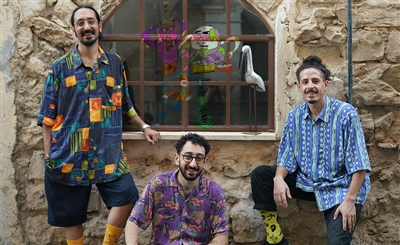The Tragic Tale Behind Fairuz’s Hit Song 'Wahdon'
Written by Lebanese poet Talal Haidar half a century ago, ‘Wahdon’ may have been inspired by an episode of loss and resistance.

In 1979, Lebanese icon Fairuz released ‘Wahdon’ (‘On Their Own’), a song by poet Talal Haidar, who may have been inspired by a true story of sacrifice and sudden loss. But what exactly is the true story behind this tragic song?
In the year 1974, under the cloak of night, three young men - a Syrian named Ahmed Al-Sheikh Mahmoud, an Iraqi named Yassin Musa, and a Palestinian named Munir Al-Maghribi - ventured into the dense forest on the edge of Lebanon. The forest had long been a silent witness to the musings of renowned poet Talal Haidar. Every morning and evening, Haidar would sip his coffee and get a breath of fresh air from the terrace of his home located at the border of a forest.-e1650086-cfbd-4da2-98ab-cebecd6da599.png) For a while, Haidar noticed three young men, unfamiliar at first, who would enter the forest each morning and return by evening. They greeted him every time they passed, and over time, their faces became familiar to him.
For a while, Haidar noticed three young men, unfamiliar at first, who would enter the forest each morning and return by evening. They greeted him every time they passed, and over time, their faces became familiar to him.
One night, as Haidar stood on his balcony, the young men appeared again, gave him their usual greeting, and disappeared into the night. That time, they would never return.
The next morning, Haidar saw their faces in the newspaper. The young men who had greeted him daily were fedayeen, Arab freedom fighters. The paper reported that they had been martyred during Operation Al-Khalisa in northern occupied Palestine on the morning of April 11th, 1974, where they took the lives of 18 Israeli soldiers. It is believed that this episode inspired his poem, ‘Wahdon’, which translates to ‘On Their Own’ in Arabic. This verse is especially evocative of the incident:
وحدن بيبقو متل زهر البيلسان
وحدهن بيقطفو وراق الزمان
بيسكروا الغابي
بيضلهن متل الشتي يدقوا على بوابي
Alone they remain, like the elderberry flowers
Alone they harvest the leaves of time
They shut down the forest
They remain like rain, knocking on my doors.
This was the story that circulated, though there isn’t solid proof connecting the poem to the events. Records show that a significant portion of Talal Haidar’s poem was published in the cultural supplement of the newspaper An-Nahar on October 16th, 1966, accompanied by a painting by the late artist Rafik Sharaf. This suggests that the poem, written eight years before the operation, may not be directly related to the event.
-97b9f063-e390-40d0-945e-1ae06716ab28.png)
Did Talal Haidar write the unpublished section of the poem during the time of the operation? This question lingers in the age of the Internet, where we are often overwhelmed by deception and falsehood.
يا ناطرين التلج ما عاد بدكن ترجعوا
صرخ عليهن بالشتي يا ديب بلكي بيسمعوا
You waiting for the snow, don't you want to come back?
Cry out for them in the rain, wolf, hoping they listen.
The poet uses the imagery of the roaring winter wind, loud enough to call out to those who are lost, hoping they might hear and return.
‘Wahdon’ was initially recorded by Lebanese singer Amal Tomb, but it was never released on disc. Instead, it only appeared as a soundtrack in the Algerian film ‘Nahla’, directed in 1979 by Farouk Beloufa.
While Ziad Rahbani’s version stayed true to the original, it boasted a slightly superior production quality, which appears in the use of echo and the space between instruments. The low-temp melancholic tonality of the track perfectly complemented the lyrics, which reflect on friendships lost over time and the emotional void they leave behind.
According to the popular story, Talal showed the lyrics to Fairuz, who sang them after her son, Ziad Rahbani, composed the music. This captured the attention of many, as it marked a turning point in Fairuz’s career. It was her first release outside of the work of Assi and Mansour Rahbani, and became part of her eighth album, ‘Wahdon’, in 1979. Before this, she had worked almost exclusively under the direction of the Rahbani brothers from 1953 to 1978.The vocals on the album were recorded entirely at Uniart Studios in Beirut, while the instrumental bases were divided: the songs for the first side were recorded at Uniart Studios, while the songs for the second side at the Emi studio in Athens.
The album achieved immediate popularity and over time became a classic, especially in Lebanon, Egypt and Syria. Many of the tracks on it have become some of the singer's most famous songs. The track ‘Wahdon’ itself is a haunting six-minute jazz ballad, characterized by a melancholic string theme, soft saxophone solos, and delicate piano flourishes. Fairuz, now 71 years strong into her career, remains a luminous figure in the Arab and Middle Eastern cultural scene.
- Previous Article Rap of the Week | Aug 17 - 23
- Next Article XP News: MENA Artists' Iconic Performances on ColorsXStudio
Trending This Month
-
Dec 24, 2025
-
Dec 23, 2025






















